The Global Business Environment: An Analysis of Volvo's Electric Cars
VerifiedAdded on 2023/01/11
|9
|2531
|86
Report
AI Summary
This report examines the global business environment of Volvo's electric car segment, focusing on the European market. It analyzes the product life cycle stages of electric vehicles, from product development to abandonment, highlighting growth opportunities and potential losses. The report applies Porter's Value Chain to assess Volvo's competitive advantages, including primary activities like inbound and outbound logistics, marketing, and services, alongside secondary activities such as technology and human resources. Furthermore, it evaluates the profitability of investments in the automobile business, comparing Volvo's strategy to that of Tesla, considering market competition, supplier power, and the threat of new entrants. The conclusion emphasizes the importance of market analysis for effective decision-making and highlights key factors that influence Volvo's value chain and market competitiveness in the UK.
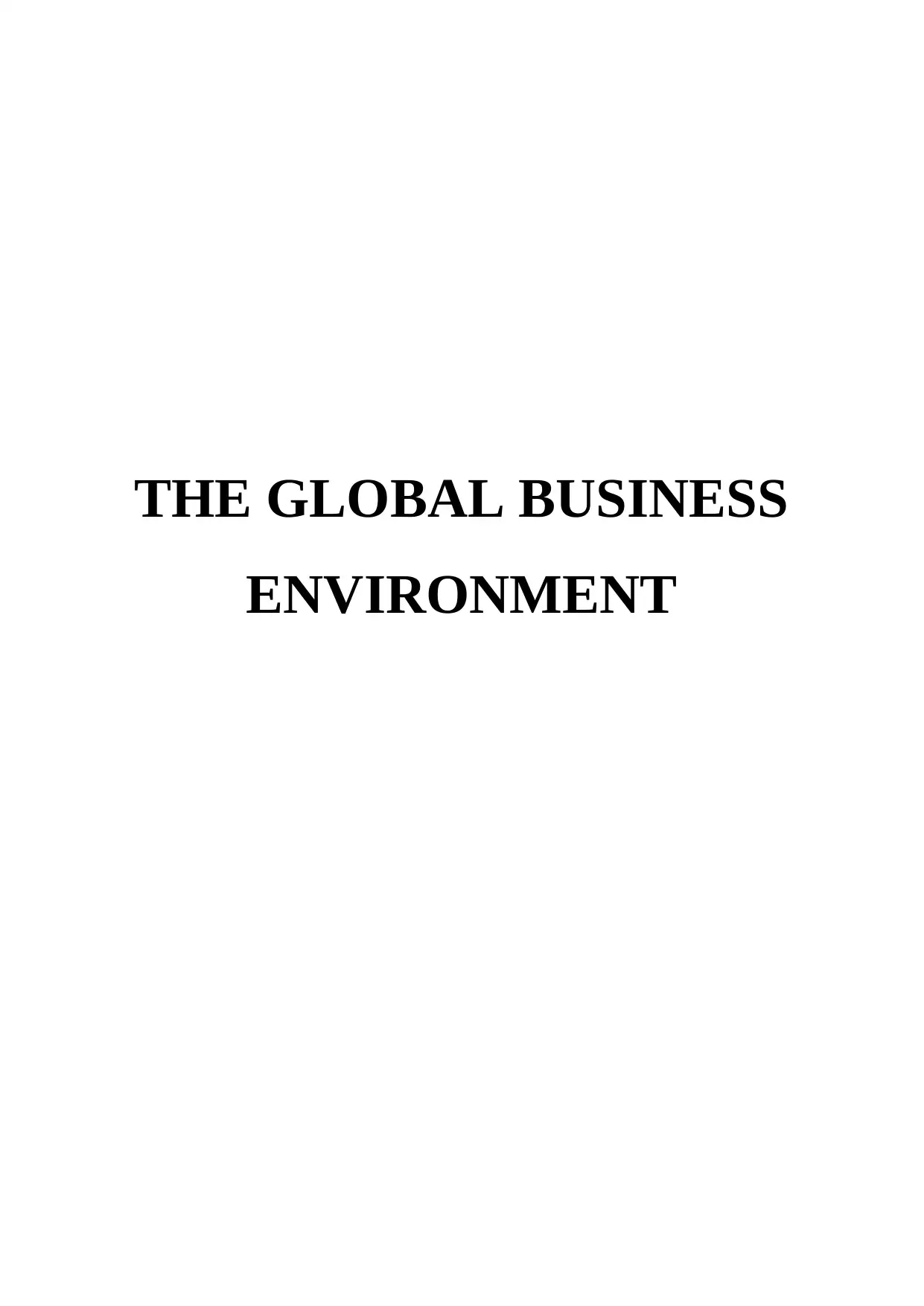
THE GLOBAL BUSINESS
ENVIRONMENT
ENVIRONMENT
Paraphrase This Document
Need a fresh take? Get an instant paraphrase of this document with our AI Paraphraser
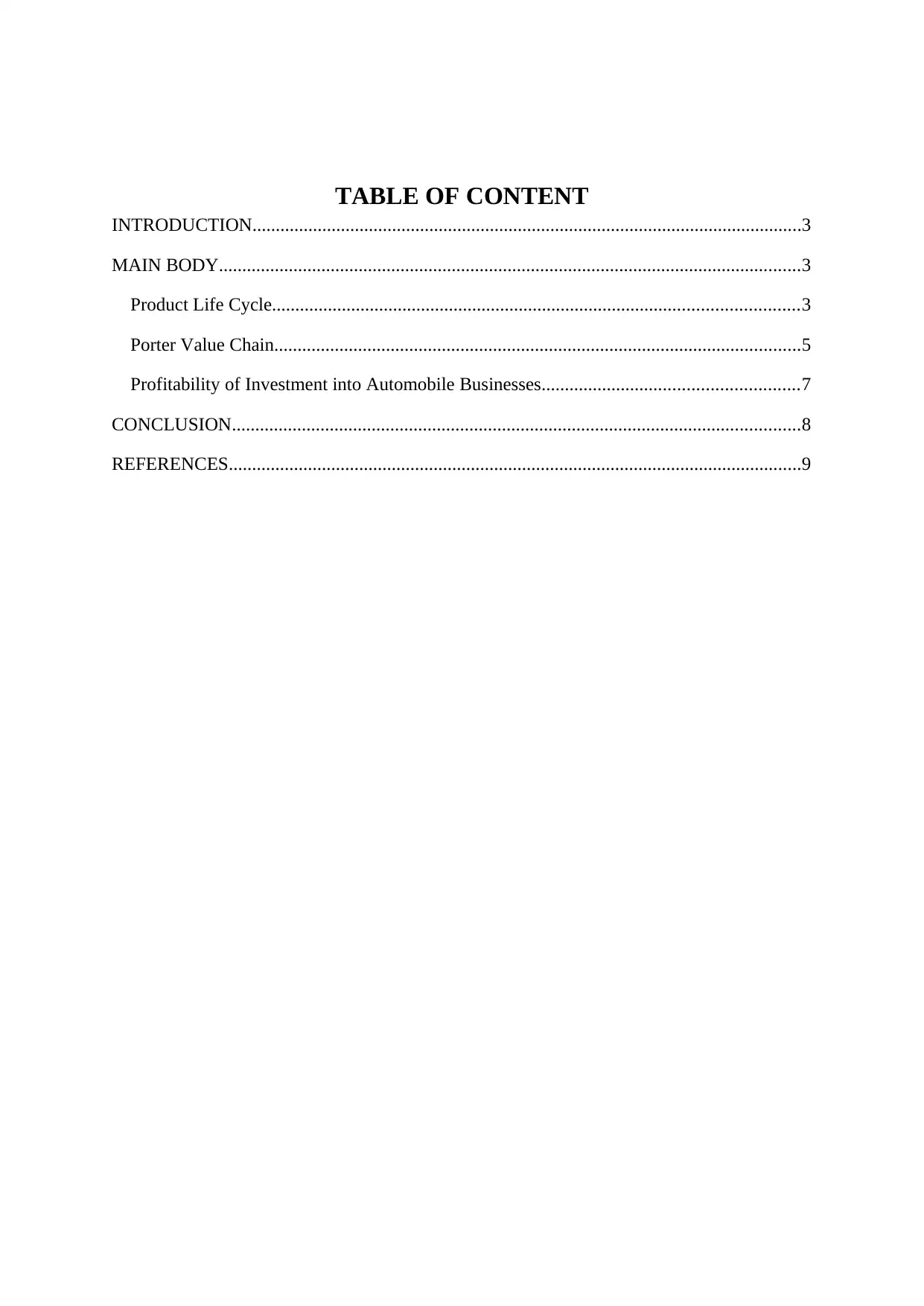
TABLE OF CONTENT
INTRODUCTION......................................................................................................................3
MAIN BODY.............................................................................................................................3
Product Life Cycle.................................................................................................................3
Porter Value Chain.................................................................................................................5
Profitability of Investment into Automobile Businesses.......................................................7
CONCLUSION..........................................................................................................................8
REFERENCES...........................................................................................................................9
INTRODUCTION......................................................................................................................3
MAIN BODY.............................................................................................................................3
Product Life Cycle.................................................................................................................3
Porter Value Chain.................................................................................................................5
Profitability of Investment into Automobile Businesses.......................................................7
CONCLUSION..........................................................................................................................8
REFERENCES...........................................................................................................................9
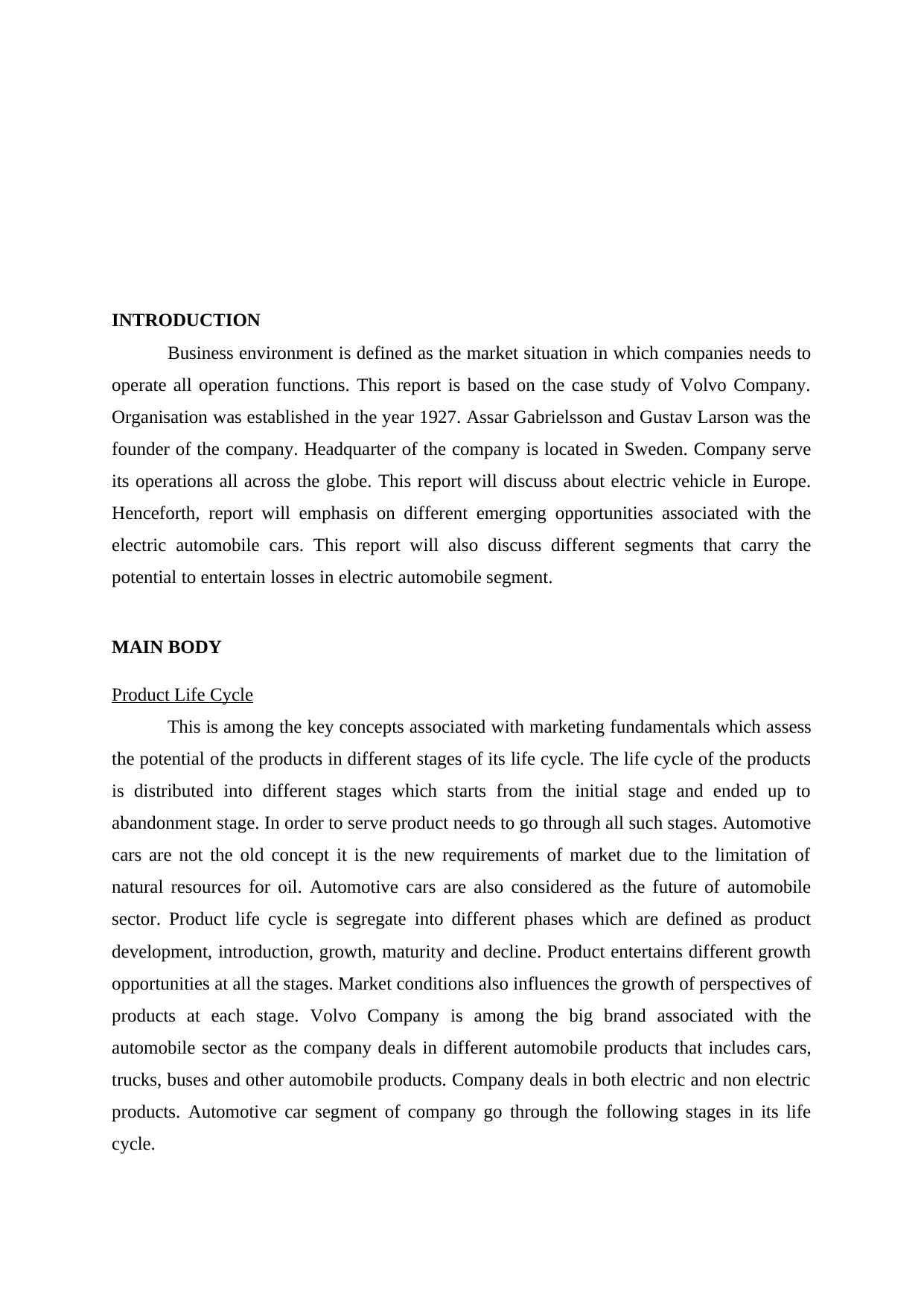
INTRODUCTION
Business environment is defined as the market situation in which companies needs to
operate all operation functions. This report is based on the case study of Volvo Company.
Organisation was established in the year 1927. Assar Gabrielsson and Gustav Larson was the
founder of the company. Headquarter of the company is located in Sweden. Company serve
its operations all across the globe. This report will discuss about electric vehicle in Europe.
Henceforth, report will emphasis on different emerging opportunities associated with the
electric automobile cars. This report will also discuss different segments that carry the
potential to entertain losses in electric automobile segment.
MAIN BODY
Product Life Cycle
This is among the key concepts associated with marketing fundamentals which assess
the potential of the products in different stages of its life cycle. The life cycle of the products
is distributed into different stages which starts from the initial stage and ended up to
abandonment stage. In order to serve product needs to go through all such stages. Automotive
cars are not the old concept it is the new requirements of market due to the limitation of
natural resources for oil. Automotive cars are also considered as the future of automobile
sector. Product life cycle is segregate into different phases which are defined as product
development, introduction, growth, maturity and decline. Product entertains different growth
opportunities at all the stages. Market conditions also influences the growth of perspectives of
products at each stage. Volvo Company is among the big brand associated with the
automobile sector as the company deals in different automobile products that includes cars,
trucks, buses and other automobile products. Company deals in both electric and non electric
products. Automotive car segment of company go through the following stages in its life
cycle.
Business environment is defined as the market situation in which companies needs to
operate all operation functions. This report is based on the case study of Volvo Company.
Organisation was established in the year 1927. Assar Gabrielsson and Gustav Larson was the
founder of the company. Headquarter of the company is located in Sweden. Company serve
its operations all across the globe. This report will discuss about electric vehicle in Europe.
Henceforth, report will emphasis on different emerging opportunities associated with the
electric automobile cars. This report will also discuss different segments that carry the
potential to entertain losses in electric automobile segment.
MAIN BODY
Product Life Cycle
This is among the key concepts associated with marketing fundamentals which assess
the potential of the products in different stages of its life cycle. The life cycle of the products
is distributed into different stages which starts from the initial stage and ended up to
abandonment stage. In order to serve product needs to go through all such stages. Automotive
cars are not the old concept it is the new requirements of market due to the limitation of
natural resources for oil. Automotive cars are also considered as the future of automobile
sector. Product life cycle is segregate into different phases which are defined as product
development, introduction, growth, maturity and decline. Product entertains different growth
opportunities at all the stages. Market conditions also influences the growth of perspectives of
products at each stage. Volvo Company is among the big brand associated with the
automobile sector as the company deals in different automobile products that includes cars,
trucks, buses and other automobile products. Company deals in both electric and non electric
products. Automotive car segment of company go through the following stages in its life
cycle.
⊘ This is a preview!⊘
Do you want full access?
Subscribe today to unlock all pages.

Trusted by 1+ million students worldwide
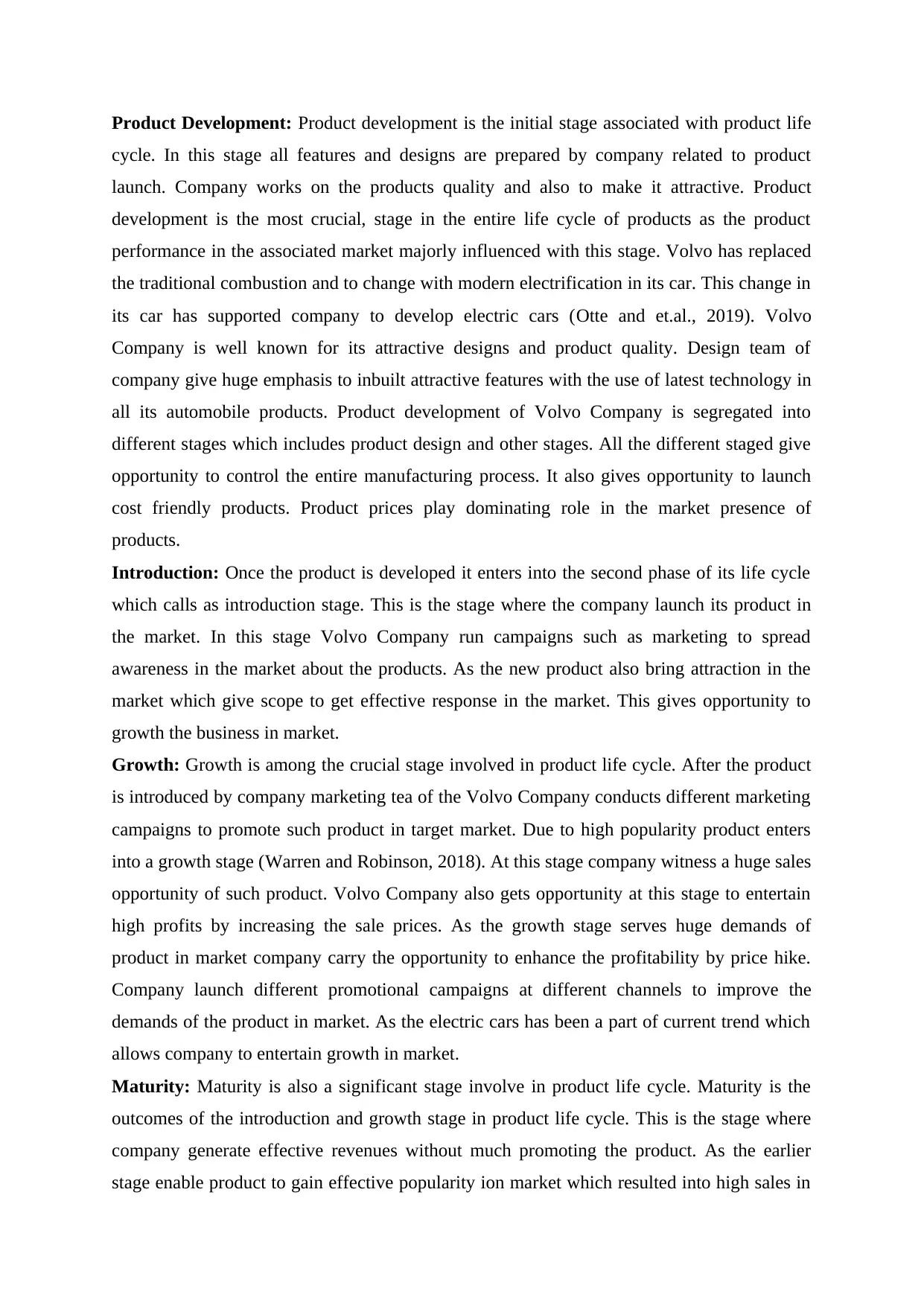
Product Development: Product development is the initial stage associated with product life
cycle. In this stage all features and designs are prepared by company related to product
launch. Company works on the products quality and also to make it attractive. Product
development is the most crucial, stage in the entire life cycle of products as the product
performance in the associated market majorly influenced with this stage. Volvo has replaced
the traditional combustion and to change with modern electrification in its car. This change in
its car has supported company to develop electric cars (Otte and et.al., 2019). Volvo
Company is well known for its attractive designs and product quality. Design team of
company give huge emphasis to inbuilt attractive features with the use of latest technology in
all its automobile products. Product development of Volvo Company is segregated into
different stages which includes product design and other stages. All the different staged give
opportunity to control the entire manufacturing process. It also gives opportunity to launch
cost friendly products. Product prices play dominating role in the market presence of
products.
Introduction: Once the product is developed it enters into the second phase of its life cycle
which calls as introduction stage. This is the stage where the company launch its product in
the market. In this stage Volvo Company run campaigns such as marketing to spread
awareness in the market about the products. As the new product also bring attraction in the
market which give scope to get effective response in the market. This gives opportunity to
growth the business in market.
Growth: Growth is among the crucial stage involved in product life cycle. After the product
is introduced by company marketing tea of the Volvo Company conducts different marketing
campaigns to promote such product in target market. Due to high popularity product enters
into a growth stage (Warren and Robinson, 2018). At this stage company witness a huge sales
opportunity of such product. Volvo Company also gets opportunity at this stage to entertain
high profits by increasing the sale prices. As the growth stage serves huge demands of
product in market company carry the opportunity to enhance the profitability by price hike.
Company launch different promotional campaigns at different channels to improve the
demands of the product in market. As the electric cars has been a part of current trend which
allows company to entertain growth in market.
Maturity: Maturity is also a significant stage involve in product life cycle. Maturity is the
outcomes of the introduction and growth stage in product life cycle. This is the stage where
company generate effective revenues without much promoting the product. As the earlier
stage enable product to gain effective popularity ion market which resulted into high sales in
cycle. In this stage all features and designs are prepared by company related to product
launch. Company works on the products quality and also to make it attractive. Product
development is the most crucial, stage in the entire life cycle of products as the product
performance in the associated market majorly influenced with this stage. Volvo has replaced
the traditional combustion and to change with modern electrification in its car. This change in
its car has supported company to develop electric cars (Otte and et.al., 2019). Volvo
Company is well known for its attractive designs and product quality. Design team of
company give huge emphasis to inbuilt attractive features with the use of latest technology in
all its automobile products. Product development of Volvo Company is segregated into
different stages which includes product design and other stages. All the different staged give
opportunity to control the entire manufacturing process. It also gives opportunity to launch
cost friendly products. Product prices play dominating role in the market presence of
products.
Introduction: Once the product is developed it enters into the second phase of its life cycle
which calls as introduction stage. This is the stage where the company launch its product in
the market. In this stage Volvo Company run campaigns such as marketing to spread
awareness in the market about the products. As the new product also bring attraction in the
market which give scope to get effective response in the market. This gives opportunity to
growth the business in market.
Growth: Growth is among the crucial stage involved in product life cycle. After the product
is introduced by company marketing tea of the Volvo Company conducts different marketing
campaigns to promote such product in target market. Due to high popularity product enters
into a growth stage (Warren and Robinson, 2018). At this stage company witness a huge sales
opportunity of such product. Volvo Company also gets opportunity at this stage to entertain
high profits by increasing the sale prices. As the growth stage serves huge demands of
product in market company carry the opportunity to enhance the profitability by price hike.
Company launch different promotional campaigns at different channels to improve the
demands of the product in market. As the electric cars has been a part of current trend which
allows company to entertain growth in market.
Maturity: Maturity is also a significant stage involve in product life cycle. Maturity is the
outcomes of the introduction and growth stage in product life cycle. This is the stage where
company generate effective revenues without much promoting the product. As the earlier
stage enable product to gain effective popularity ion market which resulted into high sales in
Paraphrase This Document
Need a fresh take? Get an instant paraphrase of this document with our AI Paraphraser
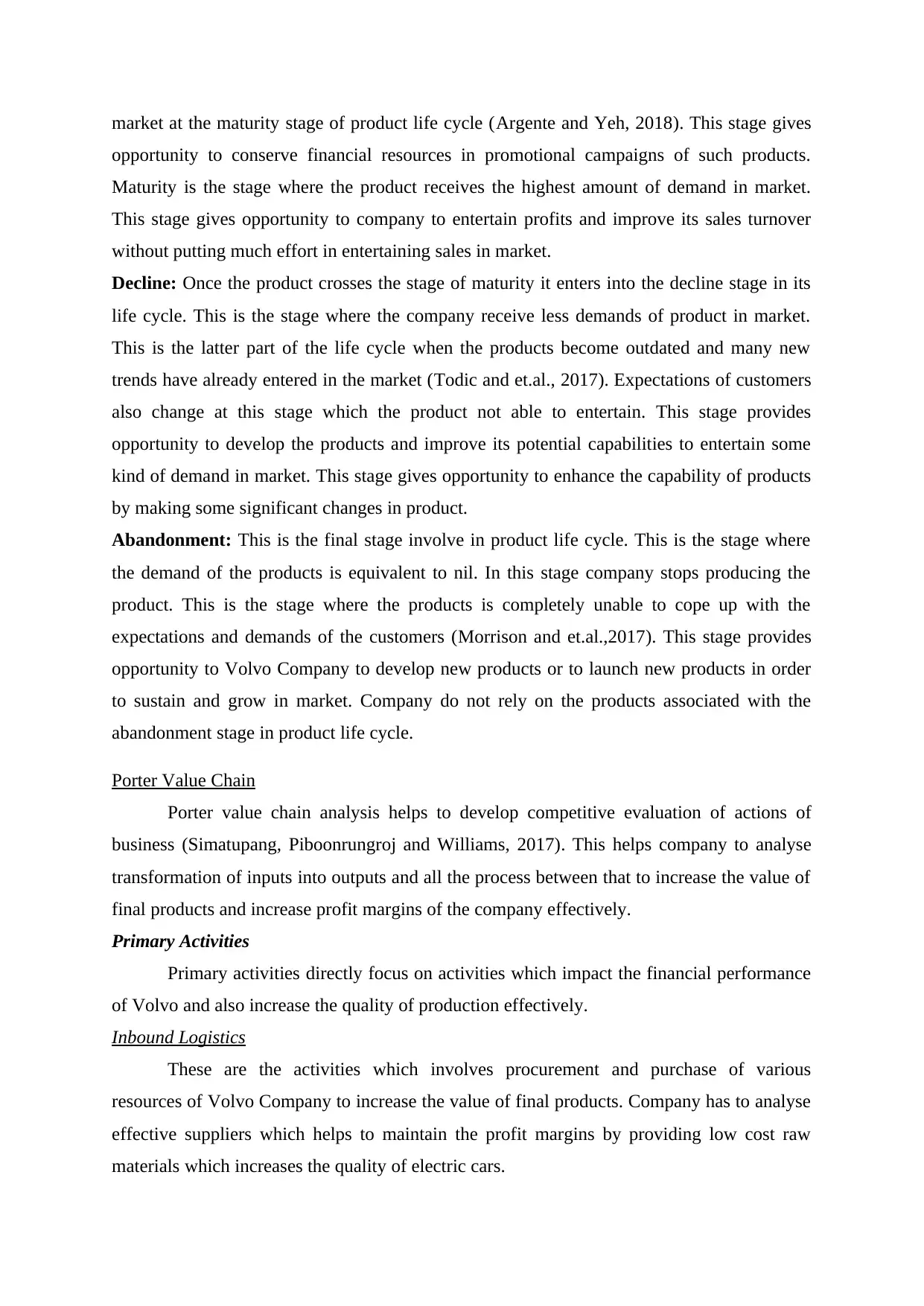
market at the maturity stage of product life cycle (Argente and Yeh, 2018). This stage gives
opportunity to conserve financial resources in promotional campaigns of such products.
Maturity is the stage where the product receives the highest amount of demand in market.
This stage gives opportunity to company to entertain profits and improve its sales turnover
without putting much effort in entertaining sales in market.
Decline: Once the product crosses the stage of maturity it enters into the decline stage in its
life cycle. This is the stage where the company receive less demands of product in market.
This is the latter part of the life cycle when the products become outdated and many new
trends have already entered in the market (Todic and et.al., 2017). Expectations of customers
also change at this stage which the product not able to entertain. This stage provides
opportunity to develop the products and improve its potential capabilities to entertain some
kind of demand in market. This stage gives opportunity to enhance the capability of products
by making some significant changes in product.
Abandonment: This is the final stage involve in product life cycle. This is the stage where
the demand of the products is equivalent to nil. In this stage company stops producing the
product. This is the stage where the products is completely unable to cope up with the
expectations and demands of the customers (Morrison and et.al.,2017). This stage provides
opportunity to Volvo Company to develop new products or to launch new products in order
to sustain and grow in market. Company do not rely on the products associated with the
abandonment stage in product life cycle.
Porter Value Chain
Porter value chain analysis helps to develop competitive evaluation of actions of
business (Simatupang, Piboonrungroj and Williams, 2017). This helps company to analyse
transformation of inputs into outputs and all the process between that to increase the value of
final products and increase profit margins of the company effectively.
Primary Activities
Primary activities directly focus on activities which impact the financial performance
of Volvo and also increase the quality of production effectively.
Inbound Logistics
These are the activities which involves procurement and purchase of various
resources of Volvo Company to increase the value of final products. Company has to analyse
effective suppliers which helps to maintain the profit margins by providing low cost raw
materials which increases the quality of electric cars.
opportunity to conserve financial resources in promotional campaigns of such products.
Maturity is the stage where the product receives the highest amount of demand in market.
This stage gives opportunity to company to entertain profits and improve its sales turnover
without putting much effort in entertaining sales in market.
Decline: Once the product crosses the stage of maturity it enters into the decline stage in its
life cycle. This is the stage where the company receive less demands of product in market.
This is the latter part of the life cycle when the products become outdated and many new
trends have already entered in the market (Todic and et.al., 2017). Expectations of customers
also change at this stage which the product not able to entertain. This stage provides
opportunity to develop the products and improve its potential capabilities to entertain some
kind of demand in market. This stage gives opportunity to enhance the capability of products
by making some significant changes in product.
Abandonment: This is the final stage involve in product life cycle. This is the stage where
the demand of the products is equivalent to nil. In this stage company stops producing the
product. This is the stage where the products is completely unable to cope up with the
expectations and demands of the customers (Morrison and et.al.,2017). This stage provides
opportunity to Volvo Company to develop new products or to launch new products in order
to sustain and grow in market. Company do not rely on the products associated with the
abandonment stage in product life cycle.
Porter Value Chain
Porter value chain analysis helps to develop competitive evaluation of actions of
business (Simatupang, Piboonrungroj and Williams, 2017). This helps company to analyse
transformation of inputs into outputs and all the process between that to increase the value of
final products and increase profit margins of the company effectively.
Primary Activities
Primary activities directly focus on activities which impact the financial performance
of Volvo and also increase the quality of production effectively.
Inbound Logistics
These are the activities which involves procurement and purchase of various
resources of Volvo Company to increase the value of final products. Company has to analyse
effective suppliers which helps to maintain the profit margins by providing low cost raw
materials which increases the quality of electric cars.
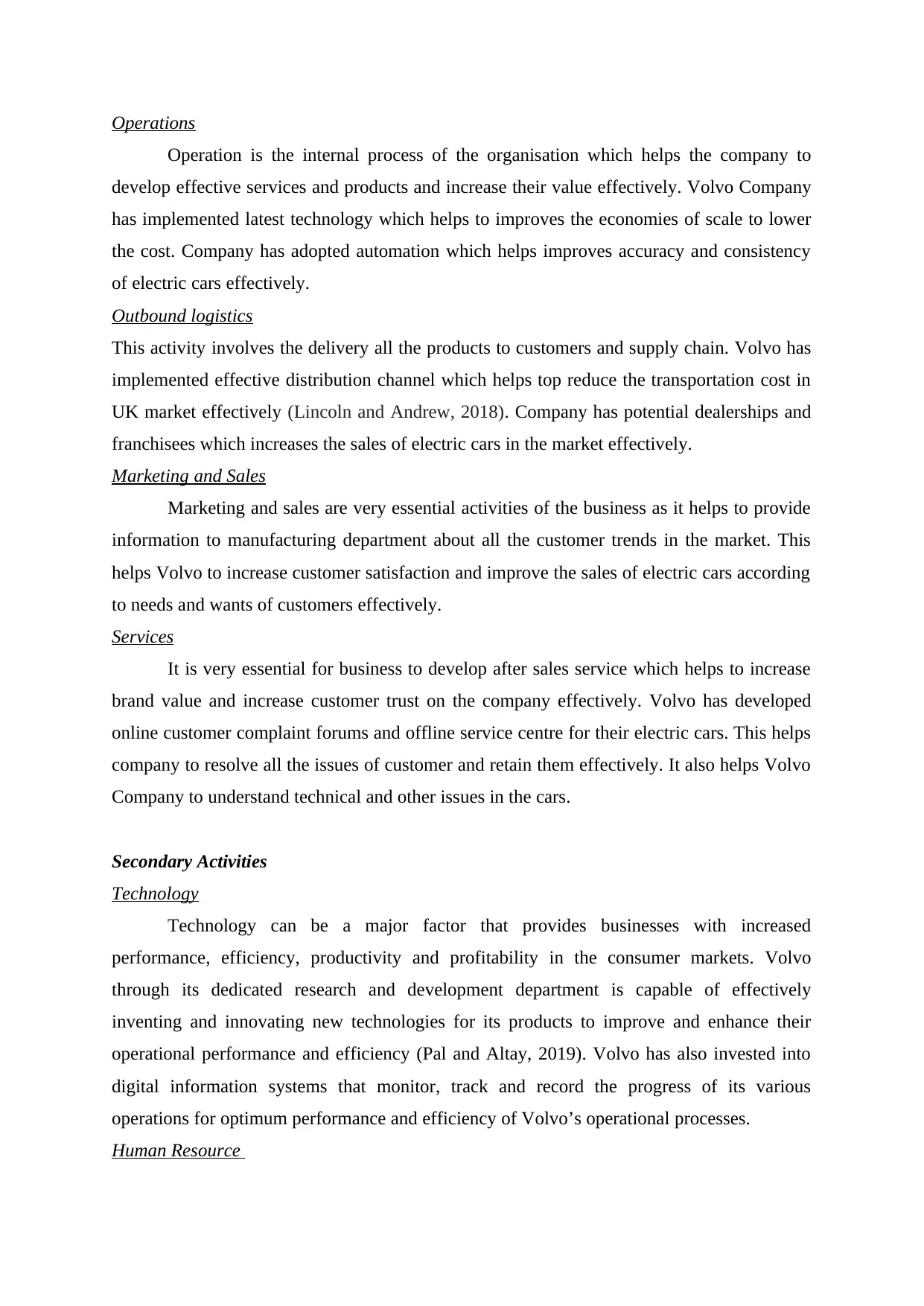
Operations
Operation is the internal process of the organisation which helps the company to
develop effective services and products and increase their value effectively. Volvo Company
has implemented latest technology which helps to improves the economies of scale to lower
the cost. Company has adopted automation which helps improves accuracy and consistency
of electric cars effectively.
Outbound logistics
This activity involves the delivery all the products to customers and supply chain. Volvo has
implemented effective distribution channel which helps top reduce the transportation cost in
UK market effectively (Lincoln and Andrew, 2018). Company has potential dealerships and
franchisees which increases the sales of electric cars in the market effectively.
Marketing and Sales
Marketing and sales are very essential activities of the business as it helps to provide
information to manufacturing department about all the customer trends in the market. This
helps Volvo to increase customer satisfaction and improve the sales of electric cars according
to needs and wants of customers effectively.
Services
It is very essential for business to develop after sales service which helps to increase
brand value and increase customer trust on the company effectively. Volvo has developed
online customer complaint forums and offline service centre for their electric cars. This helps
company to resolve all the issues of customer and retain them effectively. It also helps Volvo
Company to understand technical and other issues in the cars.
Secondary Activities
Technology
Technology can be a major factor that provides businesses with increased
performance, efficiency, productivity and profitability in the consumer markets. Volvo
through its dedicated research and development department is capable of effectively
inventing and innovating new technologies for its products to improve and enhance their
operational performance and efficiency (Pal and Altay, 2019). Volvo has also invested into
digital information systems that monitor, track and record the progress of its various
operations for optimum performance and efficiency of Volvo’s operational processes.
Human Resource
Operation is the internal process of the organisation which helps the company to
develop effective services and products and increase their value effectively. Volvo Company
has implemented latest technology which helps to improves the economies of scale to lower
the cost. Company has adopted automation which helps improves accuracy and consistency
of electric cars effectively.
Outbound logistics
This activity involves the delivery all the products to customers and supply chain. Volvo has
implemented effective distribution channel which helps top reduce the transportation cost in
UK market effectively (Lincoln and Andrew, 2018). Company has potential dealerships and
franchisees which increases the sales of electric cars in the market effectively.
Marketing and Sales
Marketing and sales are very essential activities of the business as it helps to provide
information to manufacturing department about all the customer trends in the market. This
helps Volvo to increase customer satisfaction and improve the sales of electric cars according
to needs and wants of customers effectively.
Services
It is very essential for business to develop after sales service which helps to increase
brand value and increase customer trust on the company effectively. Volvo has developed
online customer complaint forums and offline service centre for their electric cars. This helps
company to resolve all the issues of customer and retain them effectively. It also helps Volvo
Company to understand technical and other issues in the cars.
Secondary Activities
Technology
Technology can be a major factor that provides businesses with increased
performance, efficiency, productivity and profitability in the consumer markets. Volvo
through its dedicated research and development department is capable of effectively
inventing and innovating new technologies for its products to improve and enhance their
operational performance and efficiency (Pal and Altay, 2019). Volvo has also invested into
digital information systems that monitor, track and record the progress of its various
operations for optimum performance and efficiency of Volvo’s operational processes.
Human Resource
⊘ This is a preview!⊘
Do you want full access?
Subscribe today to unlock all pages.

Trusted by 1+ million students worldwide
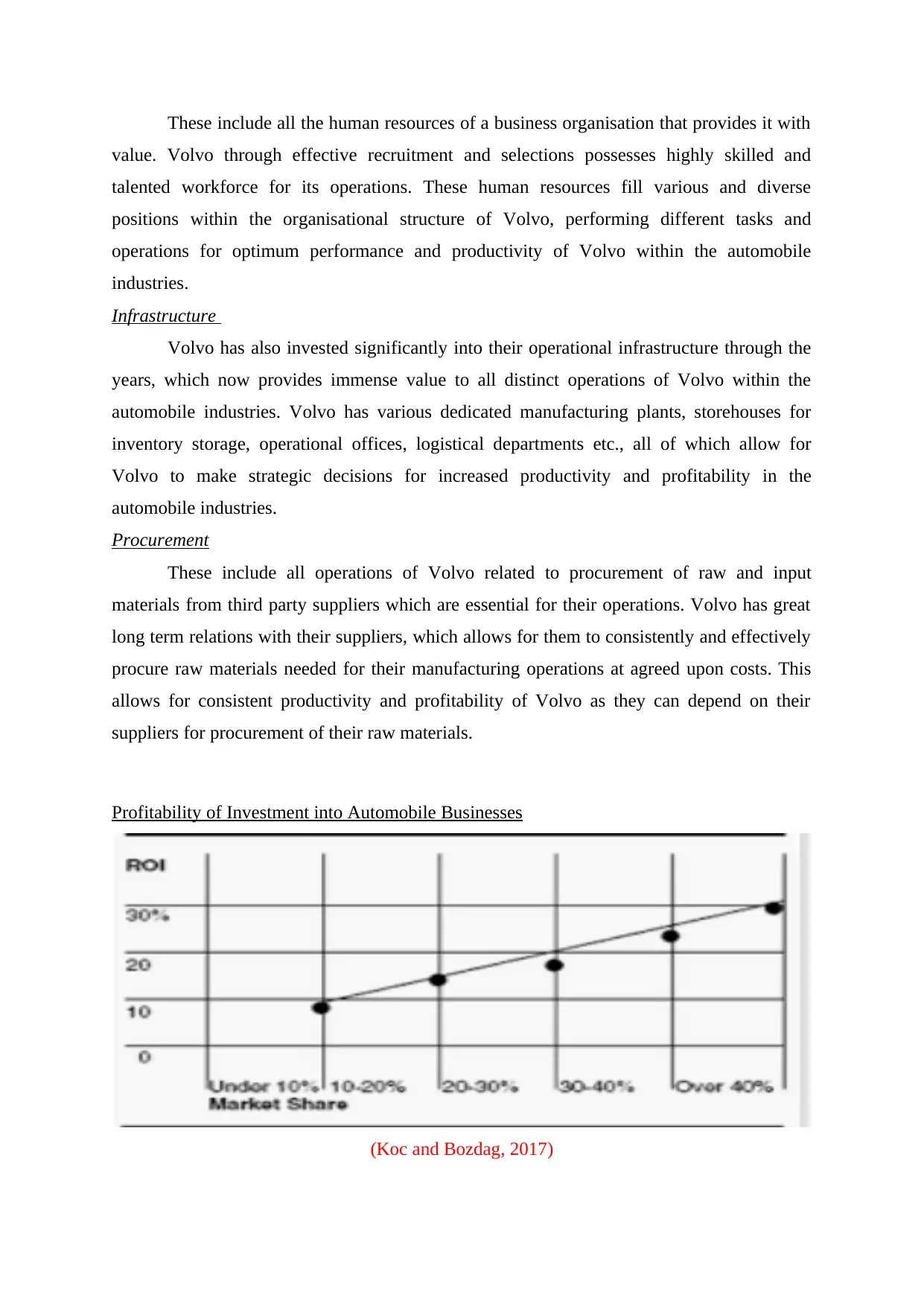
These include all the human resources of a business organisation that provides it with
value. Volvo through effective recruitment and selections possesses highly skilled and
talented workforce for its operations. These human resources fill various and diverse
positions within the organisational structure of Volvo, performing different tasks and
operations for optimum performance and productivity of Volvo within the automobile
industries.
Infrastructure
Volvo has also invested significantly into their operational infrastructure through the
years, which now provides immense value to all distinct operations of Volvo within the
automobile industries. Volvo has various dedicated manufacturing plants, storehouses for
inventory storage, operational offices, logistical departments etc., all of which allow for
Volvo to make strategic decisions for increased productivity and profitability in the
automobile industries.
Procurement
These include all operations of Volvo related to procurement of raw and input
materials from third party suppliers which are essential for their operations. Volvo has great
long term relations with their suppliers, which allows for them to consistently and effectively
procure raw materials needed for their manufacturing operations at agreed upon costs. This
allows for consistent productivity and profitability of Volvo as they can depend on their
suppliers for procurement of their raw materials.
Profitability of Investment into Automobile Businesses
(Koc and Bozdag, 2017)
value. Volvo through effective recruitment and selections possesses highly skilled and
talented workforce for its operations. These human resources fill various and diverse
positions within the organisational structure of Volvo, performing different tasks and
operations for optimum performance and productivity of Volvo within the automobile
industries.
Infrastructure
Volvo has also invested significantly into their operational infrastructure through the
years, which now provides immense value to all distinct operations of Volvo within the
automobile industries. Volvo has various dedicated manufacturing plants, storehouses for
inventory storage, operational offices, logistical departments etc., all of which allow for
Volvo to make strategic decisions for increased productivity and profitability in the
automobile industries.
Procurement
These include all operations of Volvo related to procurement of raw and input
materials from third party suppliers which are essential for their operations. Volvo has great
long term relations with their suppliers, which allows for them to consistently and effectively
procure raw materials needed for their manufacturing operations at agreed upon costs. This
allows for consistent productivity and profitability of Volvo as they can depend on their
suppliers for procurement of their raw materials.
Profitability of Investment into Automobile Businesses
(Koc and Bozdag, 2017)
Paraphrase This Document
Need a fresh take? Get an instant paraphrase of this document with our AI Paraphraser
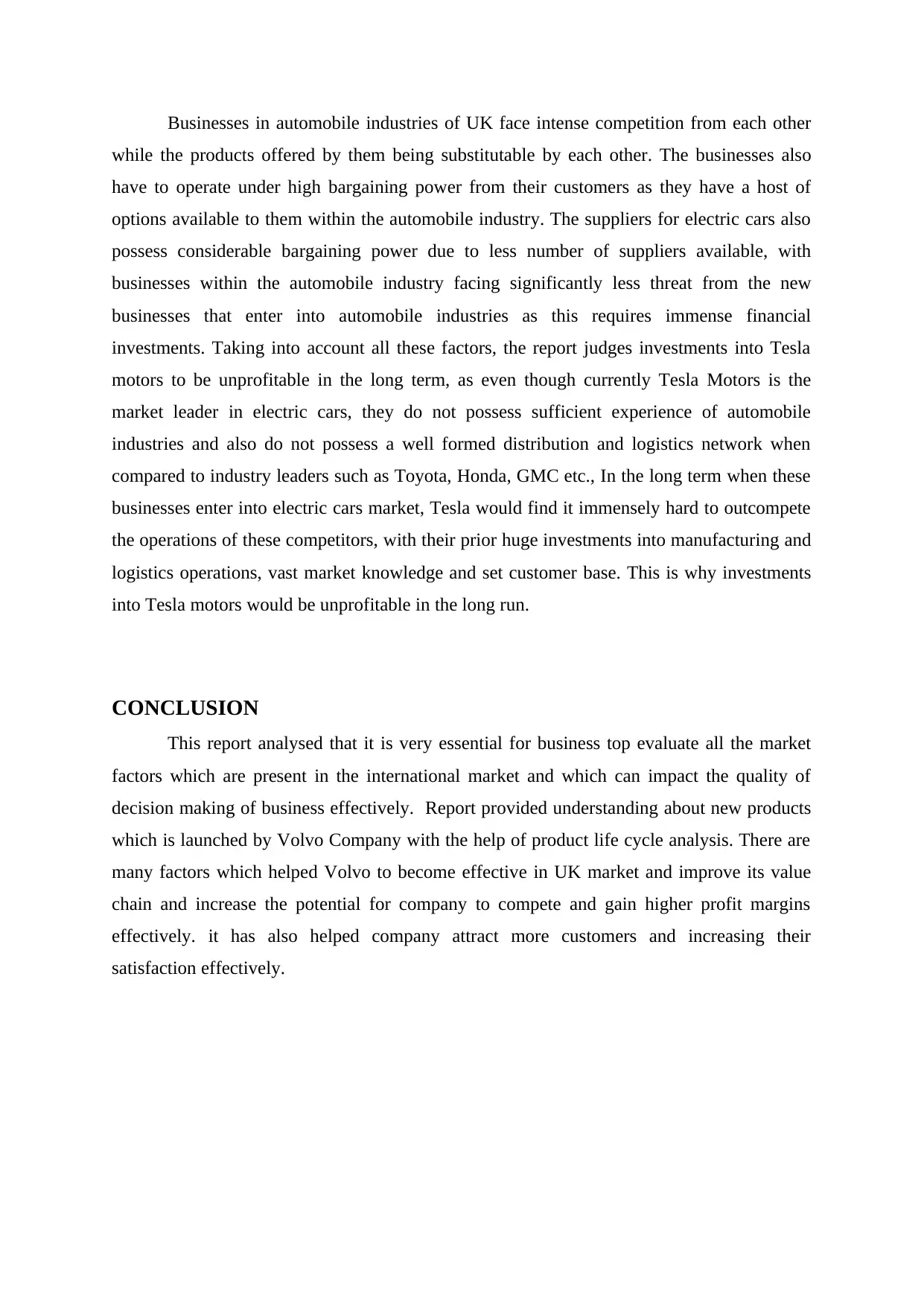
Businesses in automobile industries of UK face intense competition from each other
while the products offered by them being substitutable by each other. The businesses also
have to operate under high bargaining power from their customers as they have a host of
options available to them within the automobile industry. The suppliers for electric cars also
possess considerable bargaining power due to less number of suppliers available, with
businesses within the automobile industry facing significantly less threat from the new
businesses that enter into automobile industries as this requires immense financial
investments. Taking into account all these factors, the report judges investments into Tesla
motors to be unprofitable in the long term, as even though currently Tesla Motors is the
market leader in electric cars, they do not possess sufficient experience of automobile
industries and also do not possess a well formed distribution and logistics network when
compared to industry leaders such as Toyota, Honda, GMC etc., In the long term when these
businesses enter into electric cars market, Tesla would find it immensely hard to outcompete
the operations of these competitors, with their prior huge investments into manufacturing and
logistics operations, vast market knowledge and set customer base. This is why investments
into Tesla motors would be unprofitable in the long run.
CONCLUSION
This report analysed that it is very essential for business top evaluate all the market
factors which are present in the international market and which can impact the quality of
decision making of business effectively. Report provided understanding about new products
which is launched by Volvo Company with the help of product life cycle analysis. There are
many factors which helped Volvo to become effective in UK market and improve its value
chain and increase the potential for company to compete and gain higher profit margins
effectively. it has also helped company attract more customers and increasing their
satisfaction effectively.
while the products offered by them being substitutable by each other. The businesses also
have to operate under high bargaining power from their customers as they have a host of
options available to them within the automobile industry. The suppliers for electric cars also
possess considerable bargaining power due to less number of suppliers available, with
businesses within the automobile industry facing significantly less threat from the new
businesses that enter into automobile industries as this requires immense financial
investments. Taking into account all these factors, the report judges investments into Tesla
motors to be unprofitable in the long term, as even though currently Tesla Motors is the
market leader in electric cars, they do not possess sufficient experience of automobile
industries and also do not possess a well formed distribution and logistics network when
compared to industry leaders such as Toyota, Honda, GMC etc., In the long term when these
businesses enter into electric cars market, Tesla would find it immensely hard to outcompete
the operations of these competitors, with their prior huge investments into manufacturing and
logistics operations, vast market knowledge and set customer base. This is why investments
into Tesla motors would be unprofitable in the long run.
CONCLUSION
This report analysed that it is very essential for business top evaluate all the market
factors which are present in the international market and which can impact the quality of
decision making of business effectively. Report provided understanding about new products
which is launched by Volvo Company with the help of product life cycle analysis. There are
many factors which helped Volvo to become effective in UK market and improve its value
chain and increase the potential for company to compete and gain higher profit margins
effectively. it has also helped company attract more customers and increasing their
satisfaction effectively.
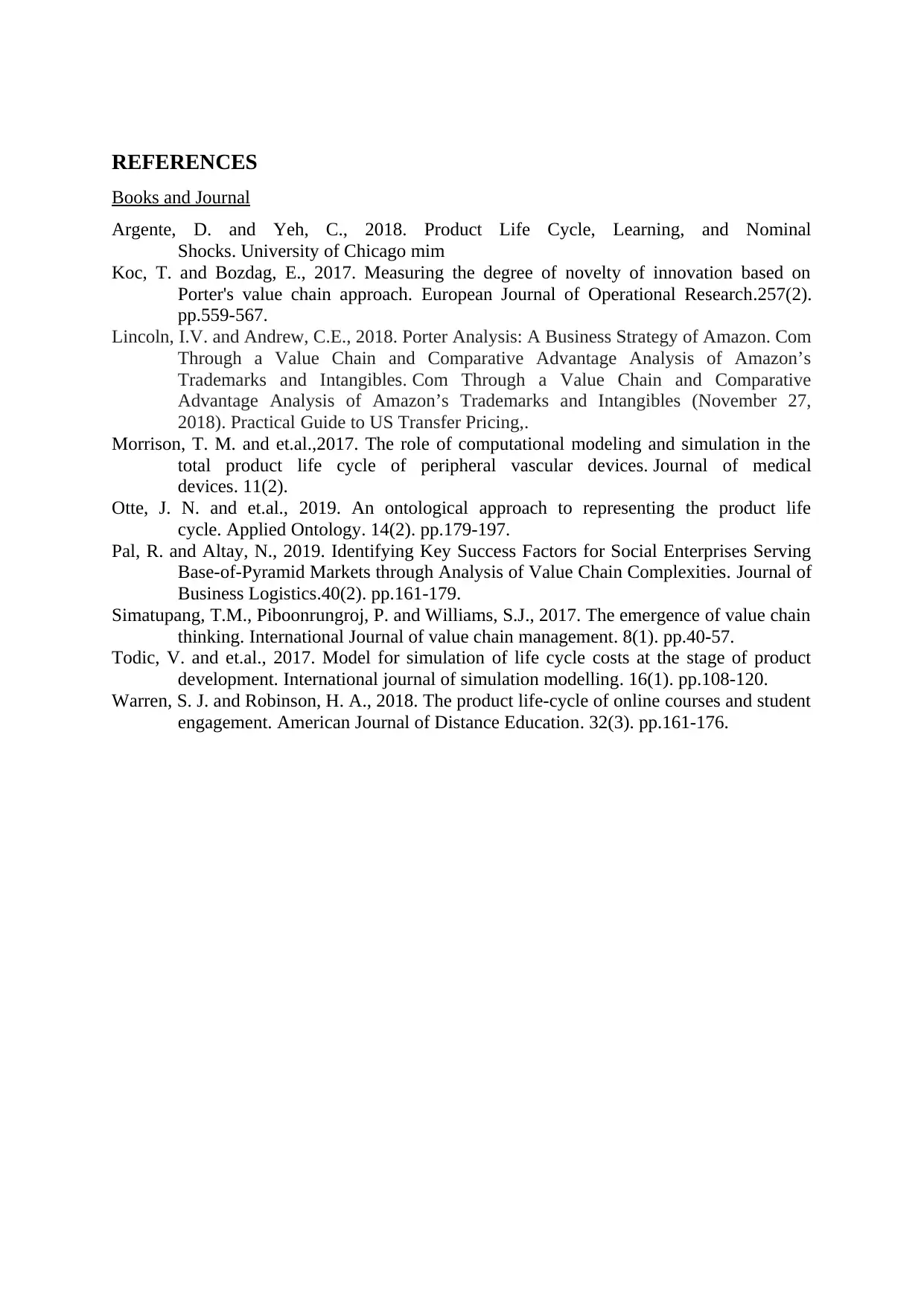
REFERENCES
Books and Journal
Argente, D. and Yeh, C., 2018. Product Life Cycle, Learning, and Nominal
Shocks. University of Chicago mim
Koc, T. and Bozdag, E., 2017. Measuring the degree of novelty of innovation based on
Porter's value chain approach. European Journal of Operational Research.257(2).
pp.559-567.
Lincoln, I.V. and Andrew, C.E., 2018. Porter Analysis: A Business Strategy of Amazon. Com
Through a Value Chain and Comparative Advantage Analysis of Amazon’s
Trademarks and Intangibles. Com Through a Value Chain and Comparative
Advantage Analysis of Amazon’s Trademarks and Intangibles (November 27,
2018). Practical Guide to US Transfer Pricing,.
Morrison, T. M. and et.al.,2017. The role of computational modeling and simulation in the
total product life cycle of peripheral vascular devices. Journal of medical
devices. 11(2).
Otte, J. N. and et.al., 2019. An ontological approach to representing the product life
cycle. Applied Ontology. 14(2). pp.179-197.
Pal, R. and Altay, N., 2019. Identifying Key Success Factors for Social Enterprises Serving
Base‐of‐Pyramid Markets through Analysis of Value Chain Complexities. Journal of
Business Logistics.40(2). pp.161-179.
Simatupang, T.M., Piboonrungroj, P. and Williams, S.J., 2017. The emergence of value chain
thinking. International Journal of value chain management. 8(1). pp.40-57.
Todic, V. and et.al., 2017. Model for simulation of life cycle costs at the stage of product
development. International journal of simulation modelling. 16(1). pp.108-120.
Warren, S. J. and Robinson, H. A., 2018. The product life-cycle of online courses and student
engagement. American Journal of Distance Education. 32(3). pp.161-176.
Books and Journal
Argente, D. and Yeh, C., 2018. Product Life Cycle, Learning, and Nominal
Shocks. University of Chicago mim
Koc, T. and Bozdag, E., 2017. Measuring the degree of novelty of innovation based on
Porter's value chain approach. European Journal of Operational Research.257(2).
pp.559-567.
Lincoln, I.V. and Andrew, C.E., 2018. Porter Analysis: A Business Strategy of Amazon. Com
Through a Value Chain and Comparative Advantage Analysis of Amazon’s
Trademarks and Intangibles. Com Through a Value Chain and Comparative
Advantage Analysis of Amazon’s Trademarks and Intangibles (November 27,
2018). Practical Guide to US Transfer Pricing,.
Morrison, T. M. and et.al.,2017. The role of computational modeling and simulation in the
total product life cycle of peripheral vascular devices. Journal of medical
devices. 11(2).
Otte, J. N. and et.al., 2019. An ontological approach to representing the product life
cycle. Applied Ontology. 14(2). pp.179-197.
Pal, R. and Altay, N., 2019. Identifying Key Success Factors for Social Enterprises Serving
Base‐of‐Pyramid Markets through Analysis of Value Chain Complexities. Journal of
Business Logistics.40(2). pp.161-179.
Simatupang, T.M., Piboonrungroj, P. and Williams, S.J., 2017. The emergence of value chain
thinking. International Journal of value chain management. 8(1). pp.40-57.
Todic, V. and et.al., 2017. Model for simulation of life cycle costs at the stage of product
development. International journal of simulation modelling. 16(1). pp.108-120.
Warren, S. J. and Robinson, H. A., 2018. The product life-cycle of online courses and student
engagement. American Journal of Distance Education. 32(3). pp.161-176.
⊘ This is a preview!⊘
Do you want full access?
Subscribe today to unlock all pages.

Trusted by 1+ million students worldwide
1 out of 9
Related Documents
Your All-in-One AI-Powered Toolkit for Academic Success.
+13062052269
info@desklib.com
Available 24*7 on WhatsApp / Email
![[object Object]](/_next/static/media/star-bottom.7253800d.svg)
Unlock your academic potential
Copyright © 2020–2025 A2Z Services. All Rights Reserved. Developed and managed by ZUCOL.





